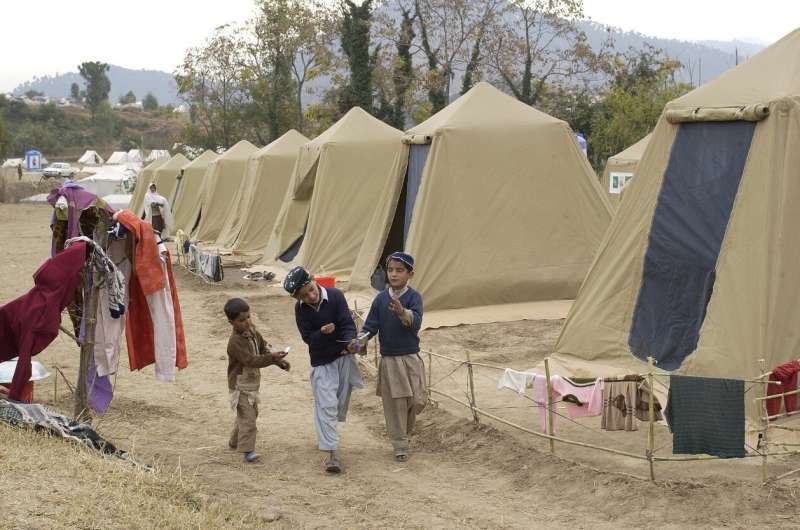Professor rethinks living spaces for refugee camps

With every touch of a screen, new technologies including smartphones and social media have made the world smaller. Rana Abudayyeh, Robin Klehr Avia Professor of Interior Design in UT's College of Architecture and Design, asks how architects respond to shifting perspectives of space, particularly for displaced people, in this age of hyperconnectivity.
"A Syrian refugee living in a Jordanian camp, or an immigrant to the United States, will have multiple associations with place enabled by digital technology," said Abudayyeh. "They may live in a new environment, but they carry archival memories and images of their home with them on smart devices, and that will influence the way they interact with their physical space."
For a recently published paper in Architecture, Media, Politics, and Society's academic journal, Architecture_MPS, Abudayyeh, who is a licensed architect in Jordan, examined the case of people living in Jordan's Zaatari camp, home to approximately 80,000 refugees from Syria. She sought to understand what their experience in a new environment can teach architects about dynamic concepts of place.
She included satellite images showing the ways Zaatari has changed since 2013, when she first visited for her research.
"Temporary shelters previously organized in single files, like in traditional camp settings, were physically moved by residents to incorporate courtyards, where dwellings of extended family members surrounded each other," Abudayyeh said.
Refugees had also planted vegetable gardens, an unexpected practice in the harsh desert climate of the camp.
"It reminded the people of home, so even though it was uncommon they shaped their environment to look like what they had fixed in their memories," Abudayyeh said.
When the initial architectural concept of Zaatari did not function for these people, they responded as displaced people have historically done.
"They transformed their environment to fit a pattern of occupancy and a culture they brought with them from Syria," Abudayyeh said. "Unlike before, however, this was facilitated by the technology in their pockets."
Abudayyeh calls what happens in Zaatari the emergence of a dynamic landscape, where a fixed expectation of what a city or camp might look like and how it might function becomes a thing of the past. Much as there is a McDonald's in every city serving the same food against distinct cultural backdrops, the connectivity of the modern world means that to a camp resident their shelter can be a place that is both Syria and Jordan.
"This has significant implications for architecture, as architecture is a discipline rooted in place," Abudayyeh said.
In the case of refugee camps, architectural responses have historically been immediate and focused on the creation of shelter units. The interior space is not designed to be influenced by inhabitants, because camps are intended to be temporary spaces.
But people are staying in camps longer than governments expect, according to Abudayyeh. In Jordan, where Abudayyeh was born and raised, former camps Jerash and Baqa'a, built to house Palestinian refugees of the 1967 Arab-Israeli War, have transformed into cities with fixed buildings replacing tents and prefabricated structures.
To address this principle, Abudayyeh has conceptualized a new design for temporary shelters that focuses on the interior space, with insertable walls, dividers, and interior surfaces that allow the residents a measure of spatial authorship based on their unique needs.
"The interior of a space carries the code of everyday life and formulates the backdrop for spatial memories that play an integral role in identity, whether a person is a refugee, migrant, or student living in university housing," Abudayyeh said.
She also suggests a new collaboration between architects, designers, planners, aid organizations, and governments to address emerging patterns of occupancy.
"The UN Refugee Agency states one person is forcibly displaced every two seconds," Abudayyeh said. "The Middle East is one of the regions where, based on precedent, displacement will happen."
"If we can embed a logistical infrastructure in host countries beforehand that addresses the needs of displaced people preemptively, it could both create a better setting for residents and provide other benefits for the host." Zaatari, which runs entirely on solar energy, benefits Jordan despite being managed primarily by international agencies.
"This is evidence that good design can pay off for host countries and institutions," Abudayyeh said.
More information: Rana Abudayyeh, Dynamic Landscapes, Emerging Territories, Architecture_MPS (2019). DOI: 10.14324/111.444.amps.2019v15i4.001
Provided by University of Tennessee at Knoxville





















